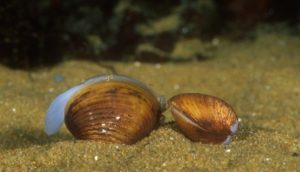Asiatic Clam
Asiatic Clam (Corbicula fluminea)
Description:
- Small, light colored bivalve (Foster et al., 2021)
- Shell color ranges from yellow-greens, browns, and hues of purple (Foster et al. 2021)
- Reaches a maximum size of 50 mm (Allen, 2019)
Habitat:
- Prefer fast, flowing water because they require high levels of dissolved oxygen (Foster et al., 2021)
- Usually found in sand and clay substrates (Foster et al., 2021)
- Low tolerance of cold temperatures (Foster et al., 2021)
Impacts & Concern:
- Large numbers of Asiatic Clams can clog power and water pipes (Foster et al., 2021)
- Alter benthic substrates and compete with native species (Allen, 2019)
Introduction:
- First seen at a farmers market in Kailua, Oʻahu in 1977 (Christennsen, 2016)
- Thought to have been smuggled in for food (Christennsen, 2016)
Distribution in Hawaii (Christennsen, 2016):
- Kauai: Present
- Oʻahu: Present
- Molokai: Not documented
- Lanai: Not documented
- Maui: Present
- Big Island: Present
References:
- Christennsen, C. (2016). Alien Freshwater Clams in the Hawaiian Islands. Bishop Museum Occasional Papers, 118, 1–4. https://hbs.bishopmuseum.org/pubs-online/pdf/op118p1-4.pdf.
- Foster, A.M., Fuller, P., Benson, A., Constant, S., Raikow, D., Larson, J., and Fusaro, A. (2021). Corbicula fluminea (O. F. Müller, 1774): U.S. Geological Survey, Nonindigenous Aquatic Species Database, Gainesville, FL, https://nas.er.usgs.gov/queries/FactSheet.aspx?speciesID=92
- Allen, U. (2019). Corbicula fluminea. [Data sheet]. CABI. https://www.cabi.org/isc/datasheet/88200
